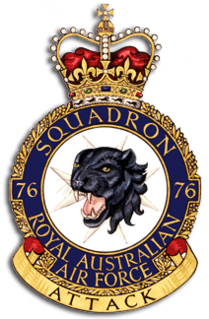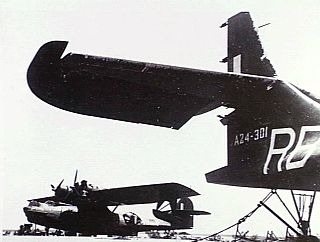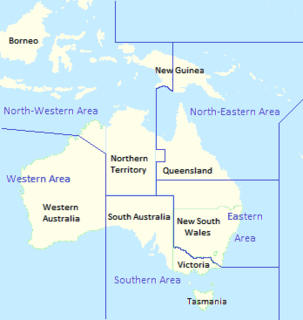The Airfield Defence Guard (ADG) mustering of the Royal Australian Air Force (RAAF) performs specialist ground defence tasks to protect air power assets from hostile ground action. The mustering is composed of non-commissioned members, commonly called 'ADGies,' most of whom are employed within a Security Forces (SECFOR) Squadron (SQN). Their primary role is the protection of RAAF equipment, personnel, assets and facilities during operations. While ADGs train to counter special forces as the primary ground threat to the projection of air power, ADGs are themselves conventional forces. Other duties include training RAAF personnel in weapon handling and basic ground defence tactics.

RAAF Base Darwin is a Royal Australian Air Force (RAAF) military air base located in the city of Darwin, in the Northern Territory, Australia. The base shares its runway with Darwin International Airport, for civil aviation purposes. The heritage-listed RAAF Base Darwin is a forward operating base with year-round activity with approximately 400 personnel.

RAAF Base Tindal is a Royal Australian Air Force (RAAF) military air base and civil aviation airfield located 8 nautical miles east southeast of the town of Katherine, Northern Territory in Australia. The base is currently home to No. 75 Squadron and a number of non-flying units, and also hosts the Katherine Tindal Civilian Airport. First constructed in 1942, it was refurbished in the late 1960s as a "bare base" capable of being utilised when required. It was opened as a permanently manned RAAF base in 1989.

No. 77 Squadron is a Royal Australian Air Force (RAAF) squadron headquartered at RAAF Base Williamtown, New South Wales. It is controlled by No. 81 Wing, and equipped with McDonnell Douglas F/A-18 Hornet multi-role fighters. The squadron was formed at RAAF Station Pearce, Western Australia, in March 1942 and saw action in the South West Pacific theatre of World War II, operating Curtis P-40 Kittyhawks. After the war, it re-equipped with North American P-51 Mustangs and deployed to Japan as part of the British Commonwealth Occupation Force. The squadron was about to return to Australia when the Korean War broke out in June 1950, after which it joined United Nations forces supporting South Korea. It converted from Mustangs to Gloster Meteor jets between April and July 1951 and remained in Korea until October 1954, claiming five MiG-15s and over five thousand buildings and vehicles destroyed during the war for the loss of almost sixty aircraft, mainly to ground fire.

No. 76 Squadron is a Royal Australian Air Force (RAAF) flight training squadron. Established in 1942, it operated P-40 Kittyhawk fighter aircraft in the South West Pacific theatre during World War II. Following the end of hostilities it re-equipped with P-51 Mustangs and formed part of Australia's contribution to the occupation of Japan until disbanding in 1948. The squadron was re-formed in 1949 and three years later transferred to Malta, where it operated de Havilland Vampire jet fighters on garrison duty until again disbanding in 1955. It was reactivated in 1960 and operated CAC Sabre and Dassault Mirage III fighters in Australia until 1973. No. 76 Squadron was re-formed in its present incarnation in 1989 and is currently stationed at RAAF Base Williamtown, New South Wales, where it operates Hawk 127 jet training aircraft.

No. 79 Squadron is a Royal Australian Air Force (RAAF) flight training unit that has been formed on four occasions since 1943. The squadron was established in May 1943 as a fighter unit equipped with Supermarine Spitfires, and subsequently saw combat in the South West Pacific theatre of World War II. Between June 1943 and the end of the war in August 1945 it flew air defence patrols to protect Allied bases and ships, escorted Australian and United States aircraft, and attacked Japanese positions. The squadron was disbanded in November 1945, but was re-formed between 1962 and 1968 to operate CAC Sabres from Ubon Air Base in Thailand. In this role it contributed to the defence of Thailand against a feared attack from its neighbouring states and exercised with United States Air Force units. No. 79 Squadron was active again at RAAF Base Butterworth in Malaysia between 1986 and 1988 where it operated Mirage III fighters and a single DHC-4 Caribou transport during the period in which the RAAF's fighter squadrons were transitioning to new aircraft.

RAAF Base Townsville is a Royal Australian Air Force (RAAF) air base located in Garbutt, 2 nautical miles west of Townsville in Queensland, Australia. It is the headquarters for No. 1 Wing Australian Air Force Cadets and, along with Lavarack Barracks, establishes Townsville as a key military centre. The base's airfield is shared with the Townsville Airport.

No. 38 Squadron was a Royal Australian Air Force (RAAF) transport and training unit active between 1943 and 2018. It was formed on 15 September 1943 and saw service during World War II transporting supplies and personnel between Australia and the combat zones in New Guinea and Borneo, using Douglas Dakota aircraft. Following the war, the squadron conducted regular courier flights between Australia and Japan in 1947 and 1948. No. 38 Squadron was deployed to Singapore from 1950 to 1952, supplying Commonwealth forces engaged in the Malayan Emergency and undertaking courier flights across Asia. In 1954 it became responsible for training RAAF personnel to operate Dakotas.

No. 452 Squadron is a Royal Australian Air Force (RAAF) air traffic control unit. It was established in 1941 as a fighter squadron, in accordance with Article XV of the Empire Air Training Scheme during World War II. The squadron flew Supermarine Spitfires for the entire war, initially over the United Kingdom and Nazi-occupied Europe. It was later based in Australia and the Netherlands East Indies, before being disbanded in 1945. It was re-raised in its current role in February 2011.
No. 44 Wing is a Royal Australian Air Force (RAAF) wing responsible for providing air traffic control services to the Australian Defence Force. It directly commands two squadrons, which in turn command eleven air traffic control flights located across the country at nine RAAF bases, HMAS Albatross and Oakey Army Aviation Centre. The wing was formed during World War II, in December 1942, and was disbanded in August 1944. It was re-established in its current form in November 2000.

No. 81 Wing is responsible for operating the McDonnell Douglas F/A-18 Hornet multi-role fighters of the Royal Australian Air Force (RAAF). Headquartered at RAAF Base Williamtown, New South Wales, the wing comprises three combat units, Nos. 3 and 77 Squadrons based at Williamtown and No. 75 Squadron at RAAF Base Tindal, Northern Territory, as well as an operational conversion unit at Williamtown. No. 81 Wing headquarters oversees squadron training in air-to-air and air-to-ground tactics, and support for the Australian Army and Royal Australian Navy. Tasked with offensive and defensive counter-air operations, the Hornets have been deployed to Diego Garcia in 2001–02, when they provided local air defence, to Iraq in 2003, when they saw action flying fighter escort and close air support missions in concert with Coalition forces, and to the Middle East in 2015–16, when they undertook strike operations during the military intervention against ISIL. They have also been employed to patrol high-profile events in Australia, including the Commonwealth Games and visits by foreign dignitaries.
No. 1 Airfield Operations Support Squadron (1AOSS) is Headquartered at RAAF Base Townsville. The squadron has detachments at each of the major RAAF Bases around Australia. It is responsible for providing fixed-base and expeditionary Air Movements support, Explosive Ordnance Disposal (EOD) functions, Airfield Engineering, including vertical and horizontal construction capabilities, and 3rd line logistics support to the RAAF's Expeditionary Combat Support Squadrons.

RMAF Butterworth is an active Air Force Station of the Royal Malaysian Air Force (RMAF) situated 4.5 nautical miles from Butterworth in Penang, Malaysia. It is currently home to the Headquarters Integrated Area Defence System (HQIADS), part of the Five Power Defence Arrangements (FPDA).

Fenton Airfield was a World War II military airfield in the Northern Territory of Australia located at Tipperary Station in what is now the locality of Douglas-Daly and named after flight lieutenant Clyde Fenton.

No. 549 Squadron RAF was a fighter squadron of the Royal Air Force (RAF) operating in Australia from 1943 to 1945.

No. 30 Transport Unit was a Royal Australian Air Force (RAAF) unit that operated during the Korean War. It was formed in November 1950 as No. 30 Communications Unit and based at Iwakuni, Japan, as part of No. 91 (Composite) Wing. The unit was initially equipped with four Douglas C–47 Dakotas and two Austers, one of the Dakotas being the personal transport of Lieutenant General Sir Horace Robertson, commander of the British Commonwealth Occupation Force (BCOF). Another four Dakotas were sent to Japan due to operational demands. The unit's role in Korea was to support No. 77 (Fighter) Squadron by transporting supplies and equipment. It also delivered materials and stores to Australian and Commonwealth ground forces, and transported VIPs of the United Nations Command. Return journeys to Japan were often used to evacuate wounded personnel from the theatre. No. 30 Communications Unit was redesignated No. 30 Transport Unit in November 1951, and re-formed as No. 36 (Transport) Squadron in March 1953. The squadron remained in Korea following the armistice, and returned to Australia in June 1955.
No. 1 Wing was an Australian Flying Corps (AFC) and Royal Australian Air Force (RAAF) wing active during World War I and World War II. The wing was established on 1 September 1917 as the 1st Training Wing and commanded the AFC's pilot training squadrons in England until April 1919, when it was disbanded. It was reformed on 7 October 1942 as a fighter unit comprising two Australian and one British flying squadrons equipped with Supermarine Spitfire aircraft, and a mobile fighter sector headquarters. The wing provided air defence to Darwin and several other key Allied bases in northern Australia until the end of the war, and was again disbanded in October 1945.

No. 76 Wing was a Royal Australian Air Force (RAAF) wing that operated during World War II. Initially based in Far North Queensland, its headquarters transferred to Darwin, Northern Territory, in September 1944 to take control of three PBY Catalina units: Nos. 20, 42, and 43 Squadrons. The prime task of these squadrons was minelaying in the South West Pacific theatre, and they conducted these operations as far afield as Java, Borneo, the Philippines, and China. As well as minelaying, No. 76 Wing's Catalinas flew bombing, patrol, and transport missions, and dropped millions of propaganda leaflets in the closing months of the war. The wing headquarters disbanded in November 1945.

No. 61 Wing was a Royal Australian Air Force (RAAF) airfield construction wing of World War II. The wing was formed in January 1943 and was disbanded in November 1945. During the war, No. 61 Wing and the units under its command served in the North Western Area and South West Pacific Area (SWPA) and played a significant role in supporting RAAF and United States Army Air Forces (USAAF) operations.

North-Western Area Command was one of several geographically based commands raised by the Royal Australian Air Force (RAAF) during World War II. Its wartime sphere of operations included the Northern Territory, adjacent portions of Queensland and Western Australia, and the Dutch East Indies. The command was formed in January 1942, following the outbreak of the Pacific War, from the western part of Northern Area Command, which had covered all of northern Australia and Papua. Headquartered at Darwin, North-Western Area Command was initially responsible for air defence, aerial reconnaissance and protection of the sea lanes within its boundaries.

















